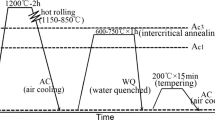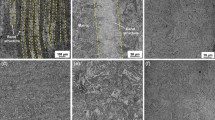Abstract
High manganese lightweight steel alloys in the Fe–Mn–Al–C system are promising alternatives to quenched and tempered Cr and Mo steels for transportation and military applications. The understanding of nonmetallic inclusion formation and their effect on the mechanical properties is of extreme importance for further alloy development. Sharp and brittle AlN forms prior to the liquidus and has been shown to decrease notch toughness. Controlled additions of sulfur may promote soft and globular MnS that precipitates around AlN during solidification, thus mitigating their detrimental effect. The effect of controlled sulfur additions from 0.004 to 0.042%S was studied in a Fe–30%Mn–9%Al–1%Si–(0.9–1.2)%C–0.5%Mo steel. The main inclusions observed were AlN, MnS, and AlN-cored MnS. Charpy impact toughness was evaluated in the solution treated condition and in specimens aged to 329–340 HBN. Toughness is a function of the overall inclusion population. In aged specimens, same was true only for steels with 0.9% carbon; above 1%C the toughness was below 15 J for any sulfur content.















Similar content being viewed by others
References
L. Bartlett, D. Van Aken, High manganese and aluminum steels for the military and transportation industry. J. Miner. Metals Mater. Soc. 66(9), 1770–1784 (2014)
R. Howell, Microstructural Influence on Dynamic Properties of Age Hardenable FeMnAl Alloys. Ph.D. dissertation, Missouri University of Science and Technology, 2009
L. Bartlett, R.A. Howell, A. Schulte, D.C. Van Aken, K. Peaslee, A review of the physical and mechanical properties of a cast high strength and lightweight Fe–Mn–Al–C, in Materials Science and Technology Conference. pp. 1941–1953 (2010)
D. Van Aken, R. Howell, L. Bartlett, A. Schulte, S. Lekakh, J. Medvedeva, V. Richards, K. Peaslee, Casting P900 armor with lightweight steel (December 2009), in 63rd Steel Founders’ Society of America Technical and Operating Conference
L. Bartlett, A. Dash, D. Van Aken, V. Richards, K. Peaslee, Dynamic fracture toughness of high strength cast steels. Int. J. Metalcast. 7(4), 17–33 (2013)
O. Acselrad, I.S. Kalashnikov, E.M. Silva, M.S. Khadyev, R.A. Simao, Diagram of phase transformation in the austenite of hardened alloy Fe–28Mn–8.5Al–1C–1.25Si as a result of aging due to isothermal heating. Metal Sci. Heat Treat. 48, 543–553 (2006)
H. Huang, D. Gan, P. Kao, Effect of alloying additions on the κ phase precipitation in austenitic Fe–Mn–Al–C alloys. Scr. Metall. Mater. 30(4), 499–504 (1994). https://doi.org/10.1016/0956-716x(94)90610-6
L.N. Bartlett, D.C. Van Aken, S. Lekakh, K.D. Peaslee, Mechanical properties of cerium-treated Fe–Mn–Al–C steel castings. AFS Trans. 119, 545–560 (2011)
L.N. Bartlett, D.C. Van Aken, Effect of aluminum and carbon on the dynamic fracture toughness of Fe–Mn–Al–C steels. AFS Trans. 121, 511–533 (2013)
H. Liu, J. Liu, S.K. Michelic, S. Shen, X. Su, B. Wu, H. Ding, Characterization and analysis of non-metallic inclusions in low-carbon Fe–Mn–Si–Al TWIP steels. Steel Res. Int. 87(12), 1723–1732 (2016)
J.H. Park, D. Kim, D.J. Min, Characterization of nonmetallic inclusions in high-manganese and aluminum-alloyed austenitic steels. Metall. Mater. Trans. A 43(7), 2316–2324 (2012)
A.M. Schulte, S.N. Lekakh, D.C. Van Aken, V.L. Richards, Phosphorus mitigation in cast lightweight Fe–Mn–Al–C steel. Trans. Am. Foundry Soc. 118, 451 (2010)
W. Werdecker, F. Aldinger, Aluminum nitride-an alternative ceramic substrate for high power applications in microcircuits. IEEE Trans. Compon. Hybrids Manuf. Technol. 7(4), 399–404 (1984)
M. Onink, C. Brakman, F. Tichelaar, E. Mittemeijer, S. Van der Zwaag, J. Root, N. Konyer, The lattice parameters of austenite and ferrite in Fe–C alloys as functions of carbon concentration and temperature. Scr. Metall. Mater. 29(8), 1011–1016 (1993)
N. Ånmark, A. Karasev, P. Jönsson, The effect of different non-metallic inclusions on the machinability of steels. Materials 8(2), 751–783 (2015)
C.E. Sims, H.A. Saller, F.W. Boulger, Sulfide inclusions in steel. Trans. Am. Found. Soc. 57, 233 (1949)
P.A. Thornton, The influence of nonmetallic inclusions on the mechanical properties of steel: a review. J. Mater. Sci. 6(4), 347–356 (1971)
I.P. Volchok, S.E. Kovchik, V.V. Panasyuk, U.A. Shulte, Effect of non-metallic inclusions on the propagation of cracks in low alloy steel 45L. Fiz. Khim. Mekhan. Mat. 3(4), 440–443 (1967)
J. Maciejewski, The effects of sulfide inclusions on mechanical properties and failures of steel components. J. Fail. Anal. Prev. 15(2), 169–178 (2015)
D. Herring (n.d.) Steel cleanliness: inclusions in steel. The Heat Treat Doctor. https://www.heat-treat-doctor.com/documents/Inclusions%20in%20Steel.pdf. Accessed 27 Oct 2017
K. Oikawa, H. Ohtani, K. Ishida, T. Nishizawa, The control of the morphology of MnS inclusions in steel during solidification. ISIJ Int. 35(4), 402–408 (1995)
S. Marich, R. Player, Sulfide inclusions in iron. Metall. Trans. 1(7), 1853–1857 (1970)
L.K. Bigelow, M.C. Flemings, Sulfide inclusions in steel. Metall. Trans. B 6(2), 275–283 (1975)
Y. Ito, N. Masumitsu, K. Matsubara, Formation of manganese sulfide in steel. Trans. Iron Steel Inst. Jpn. 21(7), 477–484 (1981)
M.E. Valdez, Y. Wang, S. Sridhar, MnS precipitation behavior in Re-sulfurized steels with intermediate levels of sulfur. Steel Res. Int. 76(4), 306–312 (2005)
ASTM International, ASTM E23-16b Standard Test Methods for Notched Bar Impact Testing of Metallic Materials, 2016
H.J. Schindler, Estimation of the dynamic J–R curve from a single impact bending test, in Mechanics of Damage and Failure: proceedings of the 11th ECF. pp. 2007–2012 (1996)
ASTM International, ASTM E1820-16 Standard Test Method for Measurement of Fracture Toughness, 2016
ASTM International, ASTM E399-12e3 Standard Test Method for Linear-Elastic Plane-Strain Fracture Toughness KIC of Metallic Materials, 2012
J.F. Kalthoff, M. Gregor, Instrumented impact testing of subsize Charpy V-Notch specimens, in STP37985S Small Specimen Test Techniques. pp. 98–109 (1998)
L. Bartlett, On the Effect of Silicon and Phosphorus During the Precipitation of k-Carbide in Fe–Mn–Al–C Alloys. Ph.D. dissertation, Missouri University of Science and Technology, 2013
ASTM International, ASTM E18-16 Standard Test Methods for Rockwell Hardness of Metallic Materials, 2016
ASTM International, ASTM E140-12be1 Standard Hardness Conversion Tables for Metals Relationship Among Brinell Hardness, Vickers Hardness, Rockwell Hardness, Superficial Hardness, Knoop Hardness, Scleroscope Hardness, and Leeb Hardness, 2012
M. Harris et al., Improved methodology for automated SEM/EDS non-metallic inclusion analysis of mini-mill and foundry steels., in The Iron & Steel Technology Conference and Exposition, May 2015 (Cleveland, 2016), pp. 3315–3325
I. Kalashnikov, O. Acselrad, A. Shalkevich, L. Pereira, Chemical composition optimization for austenitic steels of the Fe–Mn–Al–C system. J. Mater. Eng. Perform. 9(6), 597–602 (2000)
Acknowledgements
This work was supported in part by a grant from the Association for Iron and Steel Technology, AIST, Foundation as part of the Kent D. Peaslee Junior Faculty Award. The authors are very grateful to AIST for this award. The authors also gratefully acknowledge Dr. Simon Lekakh for helpful discussion and all graduate students from MS&E Department at Missouri University of Science and Technology for assistance in conducting experiments.
Author information
Authors and Affiliations
Corresponding author
Rights and permissions
About this article
Cite this article
Vaz Penna, R., Bartlett, L.N. & Constance, T. Understanding the Role of Inclusions on the Dynamic Fracture Toughness of High Strength Lightweight FeMnAl Steels. Inter Metalcast 13, 286–299 (2019). https://doi.org/10.1007/s40962-018-0273-9
Published:
Issue Date:
DOI: https://doi.org/10.1007/s40962-018-0273-9




